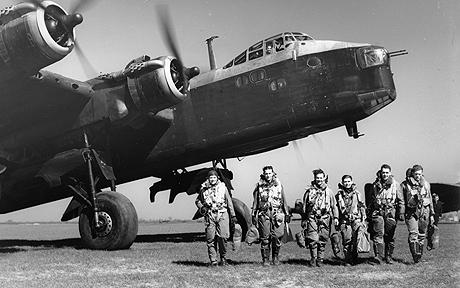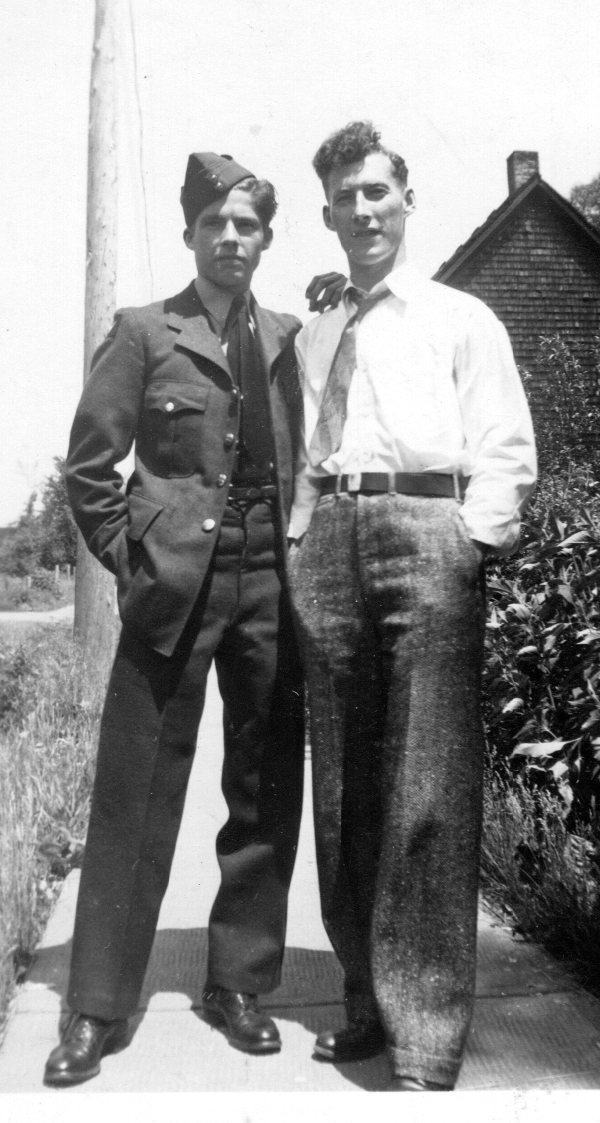The 199 Sqdn left from Lakenheath at 1944-01-29 at 18:46. Loc or duty Gardening
On Saturday 29 January 1944, a member of the 199 Sqdn, Flight Sergeant A E Sealy (R170739) as a Bomb Aimer, took off from Lakenheath in the United Kingdom. His mission is mentioned elsewhere on Back to Normandy. You can find the other details of this mission by searching here. Training and cargo flights are not separately mentioned as a mission. The plane left at 18:46.
He flew with a Short Stirling (type III, serial EF505, code EX-R).
By Norm Sheppard
When EF505 crashed in shallow water, some local residents went out to see if there were any survivors. They were forced back by German soldiers. Later, after the Germans left, the brave Danes recovered the bodies and buried them at Kirkeby cemetery, putting their lives at risk in the process. My father was a close friend of F/S Albert Edward "Red" Sealy, who was the bomb aimer on this mission. This info was given to my father by one of the people who helped bury the airmen.
My father, Corporal Clarke Edgar Sheppard, R198349, served in the RCAF here in Canada from 1942 until 1945. He was not accepted for aircrew because he had very poor vision in one eye. He wanted desperatley to be a pilot, but could not pass the vision test. He served as a draftsman and designed modifications to military aircraft for patrol duties on Canada's coastline. I have attached a picture of him at RCAF # 4 Repair Depot in Scoudouc, New Brunswick, Canada at his drafting table in 1944. After the war he became a Certified Engineering Technician and worked in that capacity for the rest of his life. He died on June 27th, 2011, aged 88 years. I have also attached a picture of him on leave while visiting a friend in Northern New Brunswick in 1944.
Campaign report of the USAAF:
29 January 1944
STRATEGIC OPERATIONS
(Eighth Air Force): Mission 198: Led by PFF aircraft, 675 B-17's and 188 B-24's are dispatched to hit the industrial area at Frankfurt, Germany; 590 B-17's and 170 B-24's hit the primary target; 46 B-17's bomb Ludwigshafen due to a deviation from planned bomb route; they claim 75-27-48 Luftwaffe aircraft; 24 B-17's and 5 B-24's are lost, 2 B-17's and 3 B-24's are damaged beyond repair and 116 B-17's and 19 B-24's are damaged; casualties are 22 KIA, 32 WIA and 299 MIA. Escort is 89 P-38's, 503 P-47's and 40 Ninth Air Force P-51's; they claim 47-6-14 Luftwaffe aircraft; 5 P-38's and 10 P-47's are lost, 1 P-38 is damaged beyond repair and 3 P-38's and 1 P-47 are damaged; casualties are 14 MIA. This is first Eighth Air Force mission in which more than 700 aircraft attack targets. Mission 199: During the evening, 5 of 5 B-17's drop 1.2 million leaflets on Lille, Tours, Lorient, Nantes and Valenciennes, France without loss. HQ 458th Bombardment Group (Heavy) arrives at Horshal St Faith, England from the US.
TACTICAL OPERATIONS
(Ninth Air Force): 80+ B-26's bomb V-weapon sites in coastal France. HQ 84th Fighter Wing arrives at Keevil, England from the US.
30 January 1944
STRATEGIC OPERATIONS
(Eighth Air Force): Mission 200: 623 B-17's and 154 B-24's are dispatched to hit aviation industry plants in Brunswick, Germany but cloud cover prevents visual bombing; 597 B-17's hit the secondary target, the city of Brunswick and 2 others hit targets of opportunity; the B-24's find dense smoke and contrails over the secondary and 104 bomb Hannover and 39 hit other targets of opportunity; the bombers claim 51-7-27 Luftwaffe aircraft; 18 B-17's and 2 B-24's are lost, 3 B-17's are damaged beyond repair and 104 B-17's and 11 B-24's are damaged; casualties are 4 KIA, 14 WIA and 206 MIA.
Escort includes 635 P-38's, P-47's and Ninth Air Force P-51's; they claim 45-15-31 Luftwaffe aircraft; 2 P-38's and 2 P-47's are lost, 2 P-38's, 3 P-47's and 2 P-51's are damaged; casualties are 1 WIA and 4 MIA. Mission 201: During the evening, 5 of 5 B-17's drop 1.2 million leaflets on Chateauroux, Brest, Chartres, Le Mans and Caen, France without loss. Mission 202: In a night Oboe Mk II test, 1 B-17 drops 2 bombs on Duren, Germany.
31 January 1944
STRATEGIC OPERATIONS
(Eighth Air Force): Mission 203: 74 of 74 B-24's hit V-weapon site construction at St. Pol/Siracourt, France; 2 aircraft are damaged beyond repair; no losses. The B-24's are escorted by 114 P-47's. Mission 204: 70 of 75 P-47 fighter-bombers, escorted by 47 P-38's and 87 P-47's bomb Gilze-Rijen Airfield, The Netherlands; they claim 13-1-1 Luftwaffe aircraft; 6 P-38's are lost, 1 P-38 is damaged beyond repair and 2 P-47's damaged; casualties are 1 WIA and 6 MIA. Transfers in England: HQ 357th Fighter Group and 362d Fighter Squadron from Raydon to Leiston with P-51's (first mission is 11 Feb); HQ 358th Fighter Group and 367th Fighter Squadron from Leiston to Raydon with P-47's and is reassigned to the Ninth Air Force on 1 Feb.
Campaign report of the RAF:
28/29 January 1944
Berlin: 677 aircraft - 432 Lancasters, 241 Halifaxes, 4 Mosquitos. Part of the German fighter force was drawn up by the early diversions and the bomber approach route over Northern Denmark proved too distant for some of the other German fighters. The German controller was, however, able to concentrate his fighters over the target and many aircraft were shot down there. 46 aircraft - 26 Halifaxes, 20 Lancasters - lost, 6.8 per cent of the force. The cloud over Berlin was broken and some ground-marking was possible but the Bomber Command claim that this was the most concentrated attack of this period is not quite fully confirmed by German records. The western and southern districts were hit but so too were 77 places outside the city.
63 Stirlings and 4 Pathfinder Halifaxes carried out minelaying in Kiel Bay 5 hours before the main Berlin operation; this was the first time that Pathfinder aircraft helped a minelaying operation. 6 Mosquitos bombed Berlin 4 hours before the main attack and 18 Mosquitos bombed night-fighter airfields at Deelen, Leeuwarden and Venlo. 4 Mosquitos carried out a diversionary raid to Hannover and 6 more Mosquitos flew Serrate patrols at the same time as the main raid. 2 Stirling minelayers and 1 Serrate Mosquito were lost from these operations. 16 OTU Wellingtons carried out leaflet flights to France without loss.
Total effort for the night: 794 sorties, 49 aircraft (6.2 per cent) lost.
29/30 January 1944
22 Mosquitos - 12 to Duisburg and 10 to Herbouville flying-bomb site - 6 OTU sorties. No losses.
With thanks to the RAF and USAAF.net!
This record can also be found on the maps of Back to Normandy with Google coordinates. You can find the maps by clicking on this link on this location.
There are several possibilities to investigate the flight records on Back to Normandy. All the flights are plotted on maps, sorted "day by day", "by squadron", "by type aircraft", "by year or month", "by location" and much more! Don't miss this!!!
If you have any information that you want to share, please add your comment at the bottom of this record. Or send your information to [email protected]. This information will be added to the record.
Your photos and your information are very welcome! The young do care and with your help we keep up the good work.





